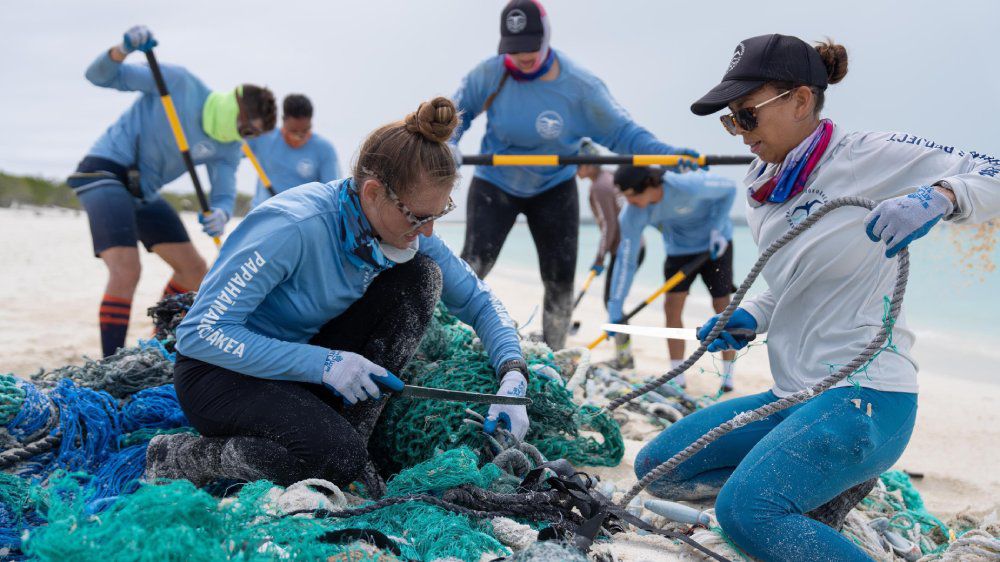
Marine Debris Removal Initiative at Papahānaumokuākea Marine National Monument
Overview of Marine Debris Challenges
The Papahānaumokuākea Marine Debris Project (PMDP), a nonprofit organization, conducts rigorous and labor-intensive efforts to remove derelict fishing gear from the Papahānaumokuākea Marine National Monument. This remote UNESCO World Heritage Site accumulates over 100,000 pounds of marine debris annually, including massive fishing nets weighing several tons and thousands of pounds of plastic pollution. Due to limited access—PMDP can only visit twice a year—an estimated backlog of 950,000 pounds of fishing nets has accumulated, many encrusted with thick marine growth that complicates removal efforts.
Marine Debris Hack-A-Thon: Innovation for Sustainable Ocean Conservation
In response to these challenges, the University of Hawaii Sea Grant College Program and PMDP have launched the inaugural Marine Debris Hack-A-Thon. This cutting-edge competition invites individuals and teams to develop innovative tools designed to efficiently cut through and remove derelict fishing nets from marine environments.
Key Objectives Aligned with Sustainable Development Goals (SDGs)
- SDG 14: Life Below Water – Protecting marine ecosystems by removing harmful debris that threatens marine species such as turtles, seals, sharks, and coral reefs.
- SDG 9: Industry, Innovation, and Infrastructure – Encouraging technological innovation through the development of next-generation marine debris removal tools.
- SDG 17: Partnerships for the Goals – Fostering collaboration among scientists, engineers, and conservationists to address marine pollution challenges.
Competition Details and Participation
- Participants must submit a video (under two minutes) or a written proposal (maximum one page) introducing themselves and their proposed tool.
- Submissions are due by 11:59 p.m. HST on July 31. Entries can be submitted via this website.
- On December 13, participants will present their designs at a celebration held at the Waikiki Aquarium.
- The grand prize winner will be announced immediately following the event.
Impact and Future Prospects
Derek LeVault, quartermaster at PMDP, emphasized the importance of this initiative: “This isn’t just a competition, it’s a challenge to push the boundaries of technology. We are in constant collaboration with other organizations and interested parties in our field, but the Hack-A-Thon provides a good opportunity to reach beyond that and find some real innovative solutions to our marine debris cutting problems.”
Improving the efficiency of cutting and removing marine debris will enable volunteers to allocate more time to locating additional debris, thereby enhancing the health of the marine sanctuary. This contributes directly to the protection of marine biodiversity and the restoration of ecosystems, supporting SDG 14.
Additional Resources
- More information about the Hack-A-Thon can be found here.
- Photo courtesy of Papahānaumokuākea Marine Debris Project/Andrew Sullivan-Haskins via University of Hawaii at Manoa:

(Photo courtesy of Papahānaumokuākea Marine Debris Project/Andrew Sullivan-Haskins via University of Hawaii at Manoa)
1. Sustainable Development Goals (SDGs) Addressed or Connected
- SDG 14: Life Below Water
- The article focuses on removing marine debris, particularly derelict fishing nets, to protect marine ecosystems in the Papahānaumokuākea Marine National Monument.
- It highlights ocean conservation efforts and the reduction of marine pollution.
- SDG 9: Industry, Innovation and Infrastructure
- The Hack-A-Thon encourages innovation by challenging participants to develop new tools and technologies for cutting and removing marine debris.
- SDG 17: Partnerships for the Goals
- The project involves collaboration between the University of Hawaii Sea Grant College Program, PMDP, and the wider community to address marine debris.
2. Specific Targets Under the Identified SDGs
- SDG 14: Life Below Water
- Target 14.1: By 2025, prevent and significantly reduce marine pollution of all kinds, particularly from land-based activities, including marine debris and nutrient pollution.
- Target 14.2: Sustainably manage and protect marine and coastal ecosystems to avoid significant adverse impacts.
- SDG 9: Industry, Innovation and Infrastructure
- Target 9.5: Enhance scientific research, upgrade the technological capabilities of industrial sectors, including encouraging innovation.
- SDG 17: Partnerships for the Goals
- Target 17.17: Encourage and promote effective public, public-private, and civil society partnerships.
3. Indicators Mentioned or Implied to Measure Progress
- Indicator for Target 14.1:
- Quantity (weight) of marine debris removed annually from the Papahānaumokuākea Marine National Monument (e.g., over 100,000 pounds collected each year, backlog of 950,000 pounds).
- Reduction in the accumulation rate of marine debris over time.
- Indicator for Target 14.2:
- Health and status of marine life affected by debris, such as turtles, seals, sharks, and coral reefs (implied through the mention of less ensnared marine life).
- Indicator for Target 9.5:
- Number and effectiveness of innovative tools developed and deployed to address marine debris removal.
- Participation rates and outcomes of innovation challenges like the Hack-A-Thon.
- Indicator for Target 17.17:
- Number and quality of partnerships formed between organizations, academic institutions, and communities to tackle marine debris.
4. Table of SDGs, Targets, and Indicators
| SDGs | Targets | Indicators |
|---|---|---|
| SDG 14: Life Below Water |
|
|
| SDG 9: Industry, Innovation and Infrastructure |
|
|
| SDG 17: Partnerships for the Goals |
|
|
Source: spectrumlocalnews.com







